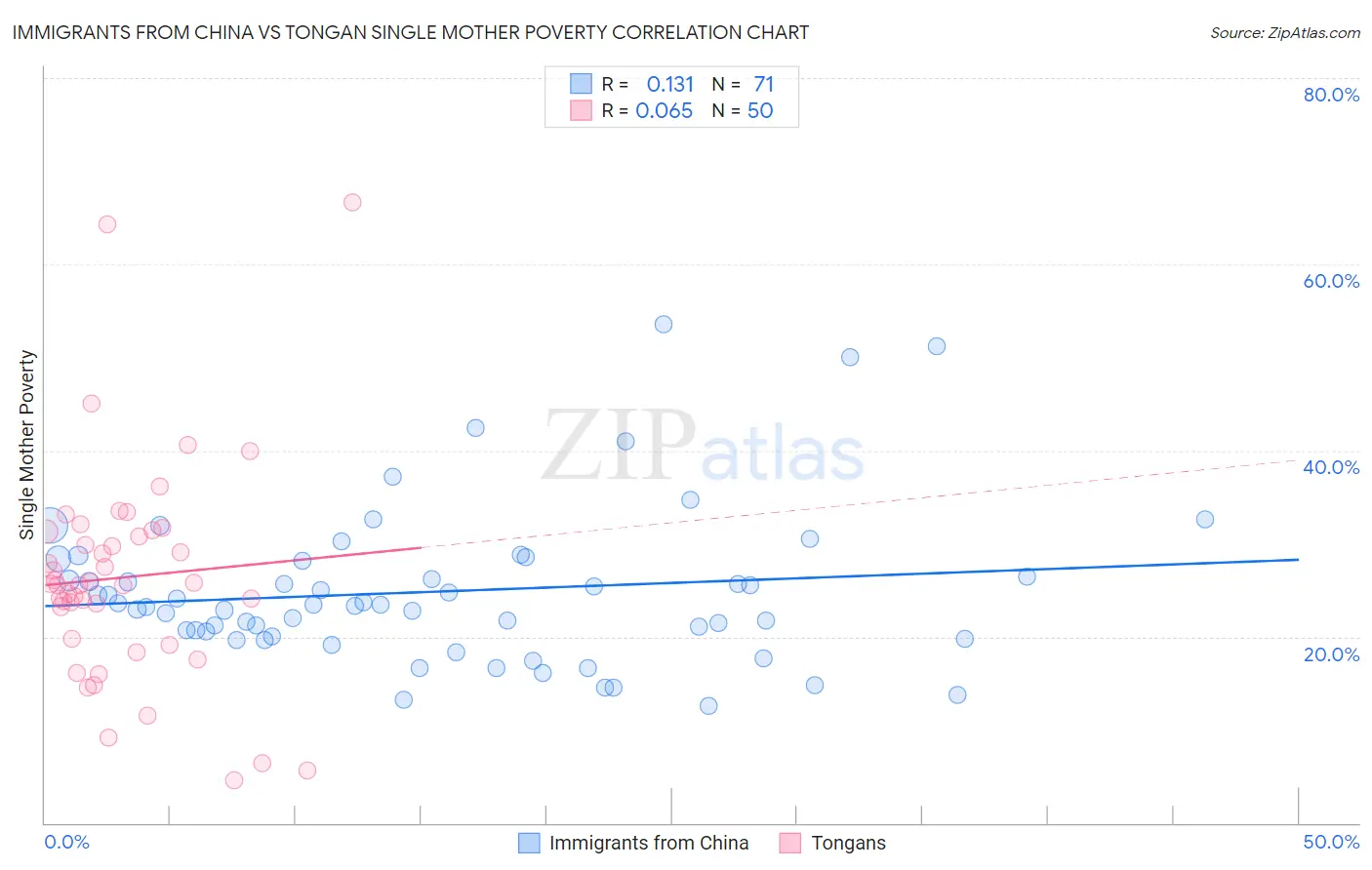Immigrants from China vs Tongan Single Mother Poverty
COMPARE
Immigrants from China
Tongan
Single Mother Poverty
Single Mother Poverty Comparison
Immigrants from China
Tongans
26.1%
SINGLE MOTHER POVERTY
100.0/ 100
METRIC RATING
20th/ 347
METRIC RANK
26.5%
SINGLE MOTHER POVERTY
99.9/ 100
METRIC RATING
32nd/ 347
METRIC RANK
Immigrants from China vs Tongan Single Mother Poverty Correlation Chart
The statistical analysis conducted on geographies consisting of 441,985,494 people shows a poor positive correlation between the proportion of Immigrants from China and poverty level among single mothers in the United States with a correlation coefficient (R) of 0.131 and weighted average of 26.1%. Similarly, the statistical analysis conducted on geographies consisting of 102,184,509 people shows a slight positive correlation between the proportion of Tongans and poverty level among single mothers in the United States with a correlation coefficient (R) of 0.065 and weighted average of 26.5%, a difference of 1.7%.

Single Mother Poverty Correlation Summary
| Measurement | Immigrants from China | Tongan |
| Minimum | 12.6% | 4.6% |
| Maximum | 53.5% | 66.7% |
| Range | 41.0% | 62.1% |
| Mean | 24.9% | 26.4% |
| Median | 23.4% | 25.6% |
| Interquartile 25% (IQ1) | 20.0% | 19.8% |
| Interquartile 75% (IQ3) | 28.2% | 31.3% |
| Interquartile Range (IQR) | 8.2% | 11.5% |
| Standard Deviation (Sample) | 8.3% | 11.8% |
| Standard Deviation (Population) | 8.2% | 11.7% |
Demographics Similar to Immigrants from China and Tongans by Single Mother Poverty
In terms of single mother poverty, the demographic groups most similar to Immigrants from China are Immigrants from Eastern Asia (26.1%, a difference of 0.13%), Immigrants from Bolivia (26.2%, a difference of 0.19%), Immigrants from Pakistan (26.0%, a difference of 0.27%), Immigrants from Korea (26.2%, a difference of 0.36%), and Burmese (26.2%, a difference of 0.54%). Similarly, the demographic groups most similar to Tongans are Bulgarian (26.5%, a difference of 0.040%), Immigrants from Indonesia (26.6%, a difference of 0.050%), Maltese (26.6%, a difference of 0.17%), Okinawan (26.6%, a difference of 0.21%), and Immigrants from Philippines (26.5%, a difference of 0.25%).
| Demographics | Rating | Rank | Single Mother Poverty |
| Bolivians | 100.0 /100 | #16 | Exceptional 25.9% |
| Asians | 100.0 /100 | #17 | Exceptional 26.0% |
| Immigrants | Pakistan | 100.0 /100 | #18 | Exceptional 26.0% |
| Immigrants | Eastern Asia | 100.0 /100 | #19 | Exceptional 26.1% |
| Immigrants | China | 100.0 /100 | #20 | Exceptional 26.1% |
| Immigrants | Bolivia | 100.0 /100 | #21 | Exceptional 26.2% |
| Immigrants | Korea | 100.0 /100 | #22 | Exceptional 26.2% |
| Burmese | 100.0 /100 | #23 | Exceptional 26.2% |
| Immigrants | Moldova | 100.0 /100 | #24 | Exceptional 26.2% |
| Immigrants | Asia | 100.0 /100 | #25 | Exceptional 26.3% |
| Immigrants | Sri Lanka | 100.0 /100 | #26 | Exceptional 26.3% |
| Immigrants | Japan | 100.0 /100 | #27 | Exceptional 26.4% |
| Koreans | 100.0 /100 | #28 | Exceptional 26.4% |
| Jordanians | 100.0 /100 | #29 | Exceptional 26.4% |
| Turks | 100.0 /100 | #30 | Exceptional 26.4% |
| Immigrants | Philippines | 100.0 /100 | #31 | Exceptional 26.5% |
| Tongans | 99.9 /100 | #32 | Exceptional 26.5% |
| Bulgarians | 99.9 /100 | #33 | Exceptional 26.5% |
| Immigrants | Indonesia | 99.9 /100 | #34 | Exceptional 26.6% |
| Maltese | 99.9 /100 | #35 | Exceptional 26.6% |
| Okinawans | 99.9 /100 | #36 | Exceptional 26.6% |